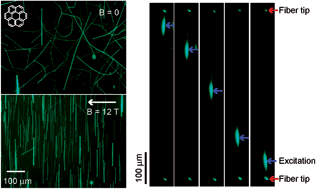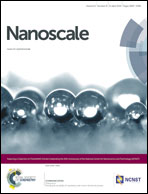Self-assembled coronene nanofibers: optical waveguide effect and magnetic alignment
Abstract
To fabricate organic nanofibers that function as active optical waveguides with semiconductor properties, a facile procedure was developed to grow single crystalline nanofibers via π–π stacking of the polycyclic aromatic molecule, coronene, through solution evaporation on a substrate. The fabricated nanofibers with millimeter-scale lengths have well-defined shapes, smooth surfaces, and low-defect structures. The nanofibers are demonstrated to function as efficient active waveguides that propagate their fluorescence (FL) along the fiber axis over their entire length. We further demonstrate that the nanofibers can be highly aligned on the substrate when solution evaporation is conducted in a magnetic field of 12 T. The mechanism of the magnetic alignment can be elucidated by considering the anisotropy of the diamagnetic susceptibility of a single coronene molecule and the crystal structure of a nanofiber. Owing to the high degree of alignment, the nanofibers rarely cross each other, allowing for measurement of the waveguiding properties of single isolated nanofibers. The nanofibers propagate their FL of λ > 500 nm with a low propagation loss of 0–3 dB per 100 μm, indicating that the nanofibers function as sub-wavelength scale, low-loss waveguides. Thus, they are promising building blocks for miniaturized optoelectronic circuits.


 Please wait while we load your content...
Please wait while we load your content...